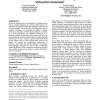132 search results - page 10 / 27 » Identifying Human Interactions in Indoor Environments |
ATAL
2005
Springer
14 years 29 days ago
2005
Springer
In the past emotions have been dismissed as a distraction to the logical, scientific thought process. More recently however, the importance of emotion in human-like intelligence a...
AVI
2006
13 years 8 months ago
2006
Tables have historically played a key role in many real-time collaborative environments, often referred to as "war rooms". Today, these environments have been transforme...
ICMI
2005
Springer
14 years 28 days ago
2005
Springer
This paper addresses the problem of detecting interaction groups in an intelligent environment. To understand human activity, we need to identify human actors and their interperso...
PERSUASIVE
2007
Springer
14 years 1 months ago
2007
Springer
An increasing number of persuasive technology systems consist of multiple devices that enable efficient just-in-time interaction with the user. Developing multi-device systems to s...
BCSHCI
2009
13 years 5 months ago
2009
This paper presents research that engages with virtual worlds for education users to understand design of these applications for their needs. An in-depth multi-method investigatio...



